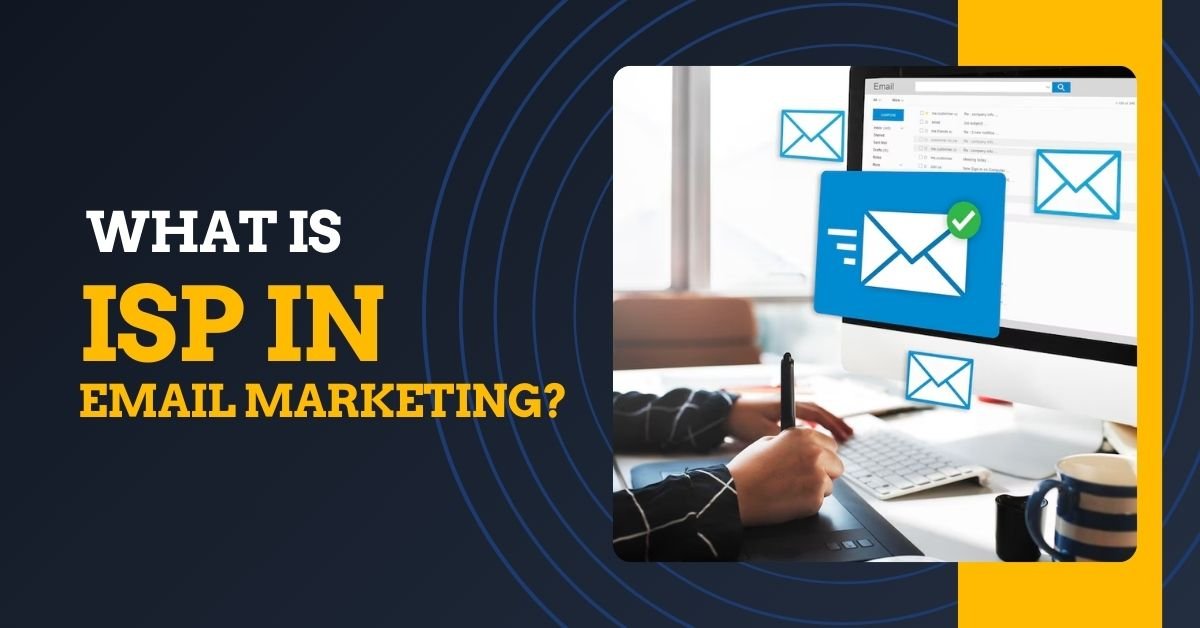What is ISP in Email Marketing?
When you start learning about email marketing, you’ll often come across a term called ISP. It may sound technical, but it’s actually a very simple concept once you understand it. In this blog, we’ll break down what ISP means, how it relates to email marketing, and why it matters for your email campaigns.
What Does ISP Mean?
ISP stands for Internet Service Provider. An Internet Service Provider is a company that gives people access to the internet. Some popular ISPs you may have heard of are Comcast, AT&T, Verizon, Spectrum, and Cox.
When you use the internet at home or on your phone, you are using the service of an ISP. That’s how you are able to browse websites, check social media, or send emails.
ISP in Email Marketing
In email marketing, ISPs are the companies that provide email services to people. For example:
- Gmail (by Google)
- Yahoo Mail (by Yahoo)
- Outlook (by Microsoft)
- AOL Mail
These email platforms are used by millions of people to send and receive emails every day. In this case, Gmail, Yahoo, and Outlook are not just email platforms – they also act as ISPs in the world of email marketing.
So, when we talk about ISPs in email marketing, we are referring to the companies that manage and protect the inboxes of email users.
How ISPs Work in Email Marketing
ISPs play a big role in deciding what happens to your marketing emails. When you send a marketing email to your subscribers, it first passes through their ISP (like Gmail or Yahoo). The ISP then checks the email and decides:
- Should this email go to the inbox?
- Should it go to the spam or junk folder?
- Should it be blocked completely?
The ISP uses many rules to make this decision. These rules are designed to protect people from unwanted emails, also known as spam.
So, if you’re sending marketing emails, the ISP is like a gatekeeper. It controls whether your email gets seen or ignored.
Why ISPs Are Important in Email Marketing
In simple words, ISPs protect users and filter emails. This means they try to make sure that only useful and safe emails reach the inbox.
For email marketers, understanding how ISPs work is very important. If an ISP thinks you are sending spam, your emails might:
- Land in the spam folder
- Be delayed
- Or get blocked completely
This can hurt your email campaign because your subscribers may never see your emails. That’s why learning how ISPs behave can help you become a better marketer.
What ISPs Check Before Delivering Emails
When an ISP receives your email, it checks many things before delivering it. Here are some of them:
1. Sender Reputation
The ISP checks your sending reputation. If you have a good history of sending clean, helpful, and safe emails, you’ll have a better chance of reaching the inbox.
If people often mark your emails as spam or if you send too many emails at once, your reputation goes down.
2. Spam Complaints
ISPs keep track of how many people report your emails as spam. If too many people complain, the ISP will think your emails are not useful and may block you.
3. Bounce Rate
When you send emails to invalid or non-working email addresses, they “bounce” back. A high bounce rate is a red flag for ISPs.
It’s important to clean your email list and only send to real, active addresses.
4. Email Content
ISPs also look at the content of your email. If your email looks like spam – using too many salesy words, strange formatting, or links to suspicious websites – the ISP might block it or send it to spam.
5. User Engagement
ISPs watch how users react to your emails. If many users open your emails, click links, or move your email to their inbox (from spam), it shows ISPs that people like your content.
Good engagement helps build your reputation with ISPs.
How to Stay on Good Terms with ISPs
Since ISPs can decide the fate of your emails, you should follow email best practices to stay on their good side.
Here are a few simple tips:
1. Build a Clean List
Only send emails to people who really want to hear from you. Never buy email lists. Always get permission before sending marketing emails.
2. Use a Recognizable Sender Name
People should be able to recognize your brand name or sender name easily. This builds trust and helps your open rates.
3. Write Good Subject Lines
Avoid spammy subject lines like “FREE MONEY!” or “CLICK NOW!”. Instead, write clear, honest, and helpful subject lines.
4. Include an Unsubscribe Link
Always allow people to unsubscribe if they don’t want to receive your emails. This reduces spam complaints and keeps your list healthy.
5. Monitor Your Campaigns
Track your email open rates, bounce rates, and spam complaints. This helps you understand how your emails are performing with different ISPs.
Different ISPs, Different Rules
Not all ISPs behave the same. Gmail, Yahoo, Outlook, and others each have their own rules and filters. This means an email might land in the inbox on Gmail, but go to spam in Outlook.
That’s why it’s important to test your emails with different email platforms. Many email tools can help you do this.
You can also check email deliverability reports to see how your emails perform across different ISPs.
Summary: ISP in Email Marketing
Let’s quickly recap what we’ve learned:
- ISP means Internet Service Provider.
- In email marketing, ISPs include email platforms like Gmail, Yahoo, Outlook, etc.
- ISPs are responsible for delivering emails and filtering spam.
- They check sender reputation, content, bounce rates, and user behavior.
- Following best practices can help your emails land in the inbox.
- Every ISP has its own rules, so testing and monitoring are key.
Final Thoughts
Understanding ISPs is a key part of successful email marketing. Even if you write the best emails, they won’t matter if they never reach your audience. That’s where ISPs come in. They are the invisible gatekeepers between you and your customers.
If you respect the rules of ISPs and focus on sending helpful, engaging content, your emails will have a much better chance of being seen.
So the next time you plan an email campaign, think about the ISP. Because when the ISP is happy, your subscribers will be too.
Also Read:
- Is Email Marketing Legit?
- How to Spy on Your Competitors’ Email Marketing Strategy
- What is a Mid-Cycle Marketing Email?
- How Can Email Marketing Fuel Your Overall Inbound Strategy?
- What Information Can the Marketer Learn from Email Marketing Analytics?
Frequently Asked Questions
What is an ISP in email marketing?
An ISP, or Internet Service Provider, is a company like Gmail, Yahoo, or Outlook that provides email services. In email marketing, they control whether your emails are delivered to inboxes, go to spam, or get blocked based on your reputation and content.
Why do ISPs block marketing emails?
ISPs block emails if they think the message is spam. This can happen if your email list is poor, the subject line is misleading, or users report your emails. ISPs want to protect their users from unwanted or harmful messages, so they use filters to decide what to allow.
How can I avoid ISP spam filters?
To avoid spam filters, send emails only to people who signed up for your list. Write clear subject lines, include a proper unsubscribe link, and don’t use spammy language. Also, check your sender reputation and make sure your email content is helpful and trustworthy.
Do different ISPs filter emails differently?
Yes, every ISP has its own rules for filtering emails. Gmail might send your message to the inbox, but Outlook might send the same one to spam. That’s why it’s important to test your emails across different email services and follow general email best practices.
What affects my sender reputation with ISPs?
Your sender reputation depends on how people react to your emails. High bounce rates, spam complaints, and low open rates can hurt your reputation. Good engagement, clean lists, and helpful content build trust with ISPs and improve your chances of reaching the inbox.


